Immune evasion of tumors in the Tasmanian devil
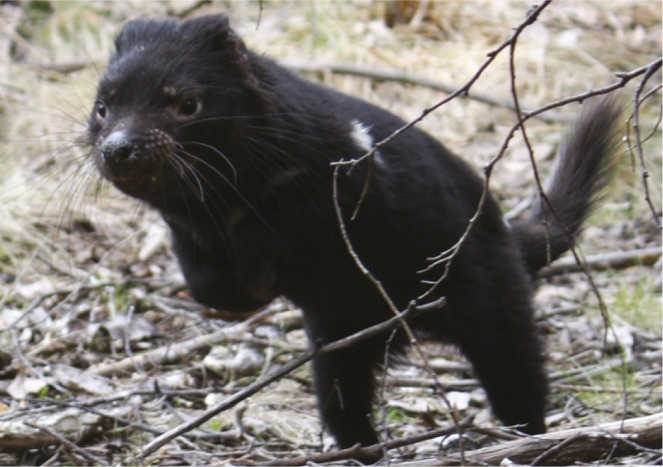
Tasmanian devil in the wild. Image courtesy of Sarah Peck (Department of Primary Industry, Parks, Water, and Environment; Tasmania).
The immune system typically prevents most cancer cells from spreading between individuals. However, devil facial tumor disease (DFTD), which is threatening the survival of Tasmanian devils, is highly contagious and can be transmitted between individuals without evoking an immune response. How DFTD cells escape immune rejection remains unclear. Hannah Siddle et al. (pp. 5103–5108) investigated the expression and regulation of major histocompatibility complex (MHC) molecules—which the immune system uses to distinguish “self” proteins from “nonself” proteins—in DFTD cells. The authors found that DFTD cells do not express cell surface MHC molecules in vitro or in vivo, due to the low expression of several genes that are involved in antigen processing and are essential for cell surface MHC expression. The authors further found that the reduced expression of these genes was not caused by structural mutations, but was instead due to epigenetic modifications that regulate gene expression. Using an immune signaling molecule that induces the expression of these genes, the authors restored cell surface MHC expression to DFTD cells in vitro and in vivo. The findings help to explain why DFTD cells escape immune rejection, and might provide clues to the development of a vaccine against DFTD, according to the authors. — N.Z.
Neonatal brain development and maternal stress
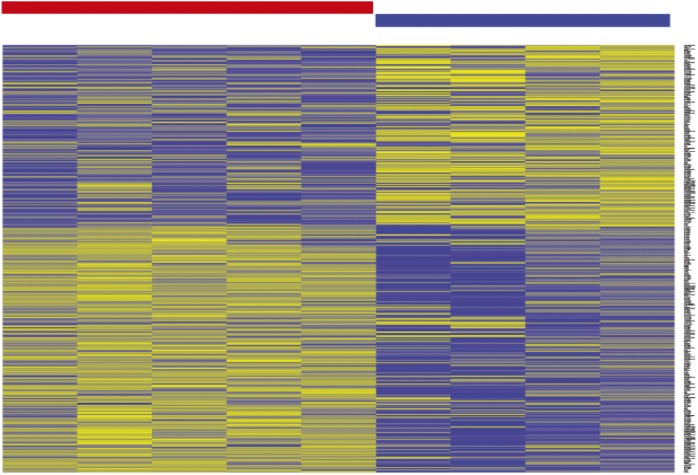
Gene expression changes in the hypothalamus of neonatal female mice due to reduced placental OGT expression. The red bar indicates WT mice and the blue bar indicates mice hemizygous for placental OGT.
Maternal stress during early pregnancy is a risk factor for disorders such as schizophrenia and autism; these conditions also demonstrate a gender bias in frequency and severity. To identify genes whose patterns of expression during gestation may be associated with increased susceptibility to neurodevelopmental disease later in life, Christopher Howerton et al. (pp. 5169–5174) focused on the placenta, which largely consists of fetal-derived tissue. Using genome-wide microarray analysis, the authors identified 2,658 placental genes whose expression levels fluctuated during early development in mice. Of these, only 11 genes demonstrated sex differences. One X-linked gene, encoding the enzyme O-GlcNAc transferase (OGT), displayed an altered level of expression following exposure of pregnant mice to stress during the first week of gestation. Female placentas expressed OGT at higher levels than males, with the lowest levels observed in stressed males. OGT expression was influenced by gender in humans, with fetal-derived (XY) cells from male placentas expressing less OGT than maternal-derived (XX) cells from the same placentas. Neonatal female mice whose placentas were engineered to express half the normal amount of OGT demonstrated broad changes in gene expression in the brain, particularly in the hypothalamus. OGT might serve as a biomarker for gestational stress exposure, according to the authors. — C.B.
Female protection against inherited autistic behavior
Autistic behavioral impairments are more common among males than females, but the reasons for this discrepancy remain unclear. Elise Robinson et al. (pp. 5258–5262) investigated the extent to which the preponderance of autistic impairments in males might be explained by a female protective effect. As autistic behaviors often run in families, a female protective effect would predict that the siblings of girls with high autistic behavior scores would carry more risk factors than the siblings of boys with high autistic behavior scores. The authors looked for this pattern in two large independent cohorts of fraternal twins: 3,842 12-year-old twin pairs in the Twins Early Development Study, based in the United Kingdom, and 6,040 9- and 12-year-old twin pairs in the Child and Adolescent Twin Study of Sweden. The authors measured the autistic behaviors of all study participants, and compared the pairs in which one twin—defined as the proband—scored above the top 10% of the autistic impairment distribution. In both study populations, siblings of female probands displayed significantly greater average impairments than the siblings of male probands. The findings provide support for the existence of a possible female protective effect against familial sources of autistic behavioral impairment, according to the authors. — N.Z.
Merged model uncovers potential Trans-Arctic shipping routes
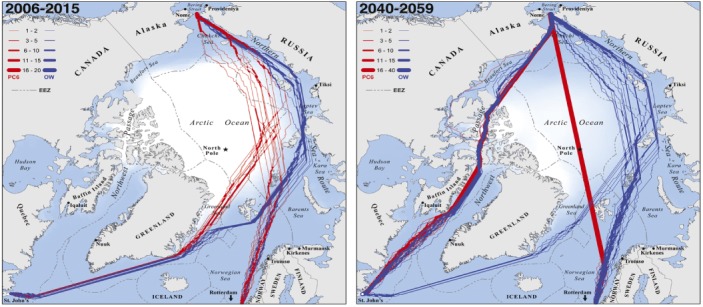
Optimal September navigation routes for ice-strengthened (red) and common open-water (blue) ships in the years 2040–2059.
Climate model projections, combined with decades of satellite observations, strongly suggest that the recent declines in late-summer Arctic sea ice are likely to continue for years. The prospect of a seasonally passable Arctic Ocean raises the question of whether new, short international shipping routes might emerge later this century, linking the Atlantic and Pacific Oceans via the Northern Sea Route or Northwest Passage. To examine this question quantitatively, Laurence Smith and Scott Stephenson (pp. 4871–4872) applied a computational model of Arctic Ocean navigability to future sea ice thicknesses projected by seven well-established, coupled atmosphere–ocean general circulation models. By midcentury, the authors report, changing sea ice will expand September navigability for common open-water ships seeking to traverse the Northern Sea Route, a key shipping lane along the Russian Arctic coast. Furthermore, open seas across the North Pole and through the Northwest Passage will offer new, robust routes to moderately ice-strengthened vessels and additional navigation options for open-water ships. The findings might help researchers and policymakers evaluate how future climate-driven changes to international shipping will affect the region, according to the authors. — T.J.
Impact of shale gas development on surface water quality in Pennsylvania
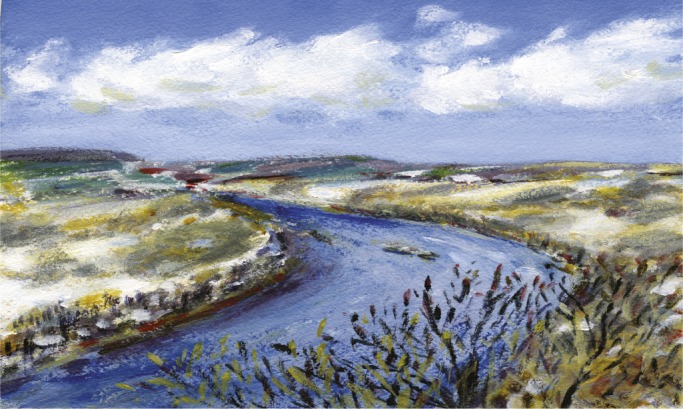
Painting of the Susquehanna River in Bradford County, PA, one of many counties currently undergoing shale gas development. Image courtesy of Lelde Muehlenbachs.
While previous studies have looked at the groundwater impacts of natural gas extraction from deep shale formations, the effects of shale gas development on surface water quality are relatively underexplored. Sheila Olmstead et al. (pp. 4962–4967) studied the Marcellus Shale in Pennsylvania and used regression analysis of more than 20,000 surface water quality observations to estimate the effects of shale gas wells and the release of treated shale gas waste on downstream water quality. The authors found that treatment of shale gas waste by treatment plants in a watershed raised downstream chloride concentrations but not the concentration of total suspended solids (TSS). In contrast, the presence of shale gas wells in a watershed raised downstream TSS concentrations but not chloride concentrations. The researchers estimated that an increase of 1.5 upstream waste treatment facilities raises downstream chloride concentrations by about 10–11%, whereas an additional 18 well pads upstream increases downstream TSS concentrations by about 5%. The study describes regulatory and voluntary changes in Pennsylvania that partially address the waste treatment impacts. The authors suggest that while groundwater concerns regarding shale gas wells may focus on contamination directly from wellbores or shale formations, surface water concerns may relate to offsite waste treatment and disposal, and land management. — S.R.
Dry season intensity, soil phosphorus predict tropical tree species
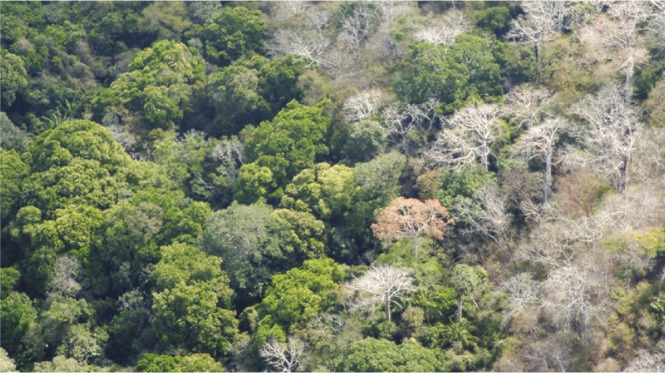
Transition between soil types reflects tree species composition. Image courtesy of Smithsonian Tropical Research Institute.
Researchers who study tropical forests seek to understand how individual tree species respond to variables such as soil characteristics and climate. However, the large number of rare tree species in tropical forests—a feature that makes such ecosystems scientifically interesting—poses a challenge to data analysis in species-specific studies. Richard Condit et al. (pp. 5064–5068) compiled tree inventories and measured soil chemistry across climatic and geological gradients in central Panama, and examined species occurrence as a function of rainfall and soil chemistry using a regression model designed to circumvent the analytical challenges presented by rare species. The results, which constitute a quantitative assessment of how 550 tree species respond to eight environmental factors, revealed that the intensity of dry seasons and soil phosphorus concentrations can predict species occurrence. In addition, the authors found that the occurrence of many species correlates with either high or low phosphorus, suggesting that the soil nutrient acts to limit tropical tree distributions. Taken together, the findings might help understand the factors that determine tree species distribution and predict future changes in forest composition, according to the authors. — T.J.


